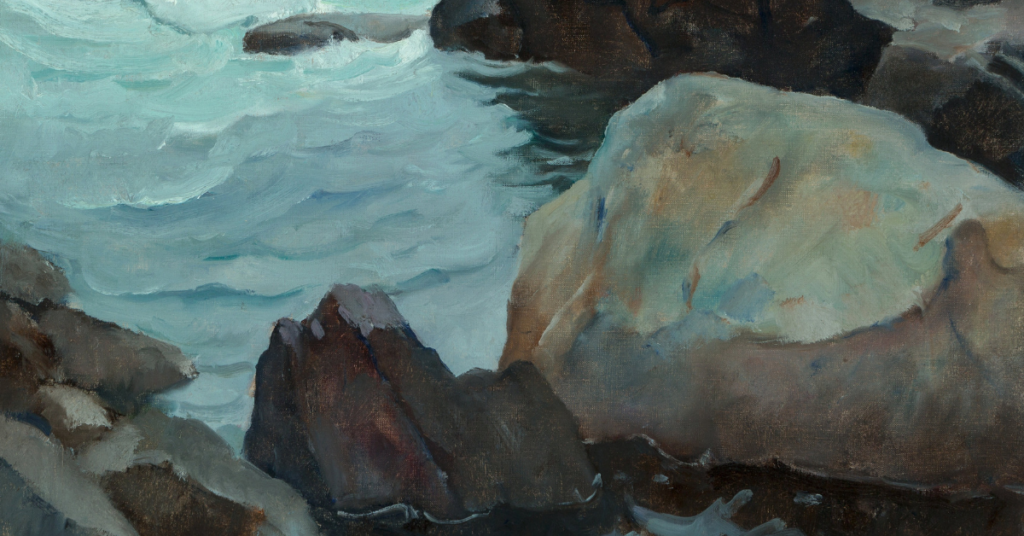
If Howard Pyle is considered the “Grandfather of American illustration,” then his arguably most successful student, Newell Convers Wyeth, would have to be thought of as the “Father.” Illustrating more than 112 books, including Treasure Island, The Last of the Mohicans, Rip Van Winkle, Robinson Crusoe and Robin Hood as well as numerous magazines including The Saturday Evening Post, Outing, Scribner’s, and Harper’s Monthly, N.C. Wyeth was one of the most prolific and successful illustration artists. Entire generations of Americans have been inspired by his artwork to imagine a world beyond their own, in a time when printed literature and the radio were the mainstays of the entertainment industry and world woes such as the Depression and World Wars limited simple pleasures. N.C. Wyeth was more than the Father of American illustration – he was the patriarch of an artistic dynasty.
Wyeth was the eldest of four rowdy boys who spent the majority of their childhoods outdoors. His mother, Henrietta, reinforced this appreciation for nature with the writings of poets Henry Wadsworth Longfellow and Henry David Thoreau, which heavily influenced the artist’s philosophy and style. She noticed her son’s artistic skills early on, and enrolled him in Massachusetts Normal Art School (now known as Massachusetts College of Art and Design) as well as in the Eric Pape School of Art.
In 1902, Wyeth began to study under Howard Pyle at his school of illustration (later renamed the Brandywine School and led by Wyeth himself). In 1903, Wyeth received his first commission: a cover for The Saturday Evening Post featuring a bucking bronco. In every painting, Wyeth conveyed a narrative with quick impressions through movement and color. His ability to create tension and gravitas through composition, by manipulating perspective and elongating shadows, was unbeatable. He placed the observer in a climactic moment, allowing the viewer’s imagination to take hold. Wyeth had a larger-than-life personality and an unstoppable imagination that drove his brush, engulfed his canvas and flooded his family life.
Wyeth married Carolyn Bockius in 1908. They had five rambunctious children – all artistically bent. The eldest child, Nathaniel Wyeth, broke slightly with the artist tradition being a mechanical engineer and inventor. He created polyethylene terephthalate, a compound that makes plastics lighter than glass, almost unbreakable and recyclable; among the way the composite is utilized to line canned drinks. Nathaniel married Caroline Pyle, the niece of Howard Pyle. Daughter Carolyn Wyeth, named after her mother, received numerous awards for her artwork, but her real legacy was in education. Carolyn taught painting for more than 30 years in Chadds Ford, Pennsylvania, and Maine. Another daughter, Henriette Wyeth, was a noted artist focusing mainly on portraits, including covers for Times magazine. She was a child prodigy, attending her father’s alma mater at age 13. Henriette married her father’s pupil, Peter Hurd, who was also a notable illustrator. Ann Wyeth, the youngest daughter, grew to become a noted musical composer whose first composition was played by the Philadelphia Orchestra when she was just 19 years old. Like her sister Henriette, Ann married one of her father’s students, John W. McCoy II, a well-known watercolorist and teacher. The youngest child and certainly the most celebrated, Andrew Wyeth was a renowned artist working primarily in tempera or watercolor (avoiding competition with his father). His most iconic work, Christina’s World, hangs in the Museum of Modern Art in New York.
N.C. Wyeth raised his children with an appreciation of nature and art with a good deal of theater. He dressed up as Santa Claus and climbed on the roof every Christmas, even going so far as to create Father Christmas models/dummies. At Halloween, the entire house would transform into a haunted mansion, with macabre and gothic décor and costumes being fundamental. “The Wyeths themselves, the art-obsessed clan who were his invention, emerge as both more likable and more Gothic than one had expected: half Pennsylvania Bruegels, half the Addams Family” (A. Gopnik, New York Times, February 2, 2007).
Wyeth’s success as an artist allowed for his children to meet with some of the leading writers, artists, actors and thinkers of their generation, including F. Scott Fitzgerald, Mary Pickford, Lillian Gish, Hugh Walpole and John Gilbert. With the exception of Nathaniel, N.C. Wyeth removed his children from public schools to take on their education himself. Andrew Wyeth later remarked, “Pa kept me almost in a jail, just kept me to himself in my own world, and he wouldn’t let anyone in on it. I was almost made to stay in Robin Hood’s Sherwood Forest with Maid Marion and the rebels” (M. Kimmelman, New York Times, August 21, 2010). This obsessive and arguably controlling parenting resulted in creative minds, but it left little room for anything else.
In his 1998 book, N.C. Wyeth, A Biography, David Michaelis portrays Wyeth as a powerful, larger-than-life character who pushed aside his insecurities with theatrical posturing and a controlling nature. Michaelis delves into the darker side of N.C. Wyeth focusing on his seemingly unhealthy relationship with his mother and his occasionally tyrannical role as patriarch of an artistic dynasty. He debates an affair between the artist Caroline Pyle, the wife of N.C.’s eldest son. Michaelis also debunks the rumors that Caroline and Nathaniel’s youngest son, Newell Convers, was the son of N.C. More importantly, the biographer discusses N.C. Wyeth and his three-year-old namesake’s deaths, leaning toward an accident on the train tracks rather than a purposeful murder-suicide. The book is a dramatic biography that gives the impression that even those pages could not contain all the genius and personality of N.C. Wyeth.
The legacy of N.C. Wyeth is rooted firmly in his art, flourishes under his children and continues in his grandchildren: artist Jaime Wyeth and musician Howie Wyeth. The Wyeth family is rightfully considered the first family of American Art. “As three generations of Wyeth painters succeeded N.C., the Wyeths would remain in the public eye as a group — an American family like the Peales, the Roosevelts, the Kennedys, and the Barrymores — their collective identity forged by a strong-armed father and dominated by the celebrity of one brother” (D. Miller, Post-Gazette, October 11, 1998).
Our upcoming American Art Auction features a handful of paintings by N.C Wyeth that depict medieval tales of romance and adventure.
 Newell Convers Wyeth (American, 1882-1945). A Cavalier, 1919.
Newell Convers Wyeth (American, 1882-1945). A Cavalier, 1919.
For more information about upcoming auctions and pricing data, visit our American Art department to browse or speak to a specialist.




Leave a Comment